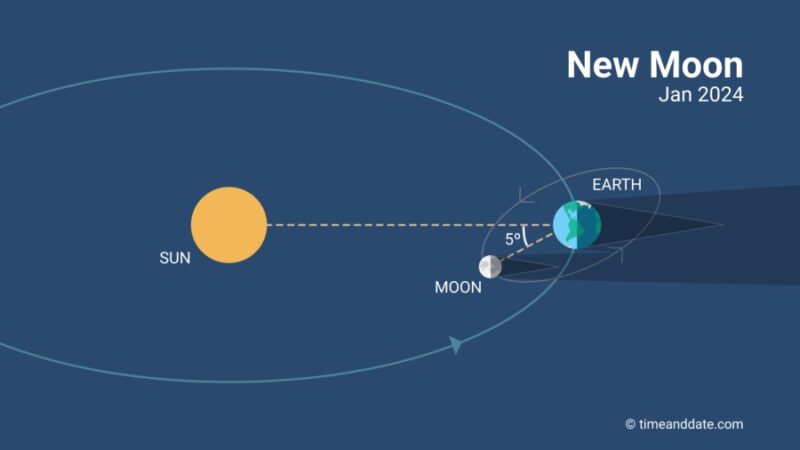[ Skywatchers ] [ Main Menu ]
47862
From: Eve, [DNS_Address]
Subject: Moon PhasesSun 2024’s biggest eclipse MISS happens January 11
URL: https://earthsky.org/moon-phases/biggest-eclipse-miss-of-2024-happens-january-11/
|
https://earthsky.org/moon-phases/biggest-eclipse-miss-of-2024-happens-january-11/ Timeanddate published this original article on January 4, 2024. Edits by EarthSky. Biggest eclipse miss of 2024 At new moon on January 11, 2024, the moon will “miss” the sun on our sky’s dome by a relatively large distance: 4.99 degrees. That’s about the width of three fingers held at arm’s length. And it’s around 10 times the width of the sun in the sky, making it the biggest eclipse miss of the year. As a result, it will also be the most-illuminated new moon of 2024. At the precise moment of new moon – 11:57 UTC on January 11 – the moon will be 0.19% lit. The lit portion of a crescent moon is, of course, a glimpse of the moon’s day side. So, strictly speaking – instead of its day entirely turned away from Earth – the January 2024 new moon will appear as a vanishingly thin crescent moon. What makes an eclipse? To have a solar eclipse, the moon must be at the new phase. We generally say that new moon is when the moon passes between Earth and the sun. It’s when the moon is 0% lit as seen from Earth. This is roughly what happens … but not exactly. If the new moon passed exactly between Earth and the sun every month, it would produce a solar eclipse each time. Instead, the moon normally passes a little bit above or below the sun in the sky.  At new moon, the sun, Earth and moon are aligned in space, with the moon in the middle. The moon crosses the sky with the sun during the day. The moon’s night side – its darkened hemisphere – directly faces us, so, generally speaking, you can’t see the moon that day. On the other hand, January’s new moon – on January 11, 2024 – will be an ultra-thin crescent, because it’s farther from perfect alignment than other months. It’s the biggest eclipse miss of 2024! Image via timeanddate.com. Used with permission. Why it’s a big eclipse miss Solar eclipses happen when the sun, Earth and moon come into alignment at new moon. This alignment doesn’t occur at every new moon, because the moon’s orbit is tilted by about 5 degrees. You can see the tilt in the not-to-scale illustration above. At new moon in January 2024, the moon is close to its farthest distance beneath the plane of Earth’s orbit. This imbalance produces the biggest possible eclipse miss. Read more: Total solar eclipse in North America April 8, 2024 A fraction of a percent of illumination Likewise, the imperfect sun-moon-Earth alignment shown above is the reason the illumination of the moon’s disk doesn’t quite drop to zero. In fact, this happens to some extent at most new moons. The following table shows the percentage of the lit moon, as seen from Earth, at every new moon in 2024. (That’s if you could see the new moon in the glare of the sun from Earth!)  This chart shows the percent illumination of each new moon of 2024. Chart via timeanddate.com. Used with permission. --Two perfect alignments in 2024-- There are two new moons in the above table, on April 8 and October 2, when the moon’s illumination drops to 0.00%. This is because there is a perfect alignment of the sun, moon and Earth on these dates … which also means there is a solar eclipse. The new moon of April 8 will produce a total eclipse across parts of Mexico, the United States and Canada. Six months later, the new moon of October 2 will produce an annular eclipse across Rapa Nui (Easter Island) and the southern tip of Chile and Argentina. Expert photographers might catch January’s eclipse miss It’s important to note that – for most of us – the thread-like crescent of the new moon will invisible. Like most new moons, it’ll be utterly lost in the dazzling glare of the sun. But expert photographers might try to catch it. Check out the top of this post to see another vanishingly thin crescent moon, at the exact moment of new moon. Master astrophotographer Thierry Legault caught it in the year 2013. WARNING: Never look directly at the sun, and never point a telescope or binoculars in the direction of the sun. It can cause serious and permanent eye damage in seconds. Bottom line: January’s new moon will be an ultra-thin crescent moon due to its less-than-perfect alignment with the sun and Earth. It will also be the biggest eclipse miss of the year. |
Responses:
[47863]
47863
From: Eve, [DNS_Address]
Subject: Re: Moon PhasesSun 2024’s biggest eclipse MISS happens January 11
|
audio visual, nearly 3 min. view. |
Responses:
None
[ Skywatchers ] [ Main Menu ]